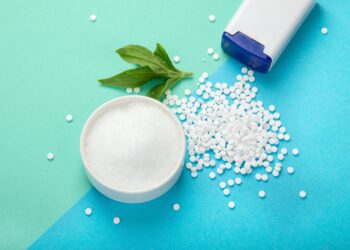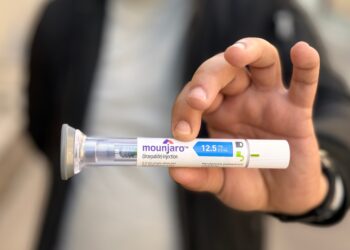In the United States, the highly transmissible Delta variant is driving an uptick in COVID-19 cases, primarily among the unvaccinated. But the good news is, as the weeks pass, more reports have been coming out about the effectiveness of the vaccines that are in use and the potential of those still in development. So, how do they differ?
It’s important to keep up, but it’s also a daunting task, given the flood of information (and misinformation) coming at us from so many directions.
Vaccines from Pfizer-BioNTech, Moderna, and Johnson & Johnson are being administered in the U.S. The FDA has authorized—and the CDC has approved—booster shots for all three vaccines, along with a “mix-and-match” approach that would allow people to choose a different vaccine for their booster than the one they started with.
We mapped out a comparison of the most prominent COVID-19 vaccines.
Pfizer-BioNTech
Pfizer-BioNTech was the first COVID-19 vaccine to receive full Food and Drug Administration (FDA) approval for people ages 16 and older in August 2021. It was also the first COVID-19 vaccine to receive FDA Emergency Use Authorization (EUA) back in December 2020, after the company reported its vaccine was highly effective at preventing symptomatic disease. This is a messenger RNA (mRNA) vaccine, which uses a relatively new technology. It must be stored in freezer-level temperatures, which can make it more difficult to distribute than some other vaccines.
Status:
Approved for ages 16 and older in the U.S., with EUA for ages 5-15, and in other countries, including in the European Union (under the name Comirnaty), for specified age groups. Pfizer-BioNTtech booster doses are available to all adults older than 18 six months after their initial Pfizer or Moderna shot, or two months after their Johnson & Johnson shot. (A mix-and-match policy means that any of the three COVID-19 vaccines available in the U.S. can be taken as a booster shot, regardless of the vaccine used for the primary vaccination.) People with certain immunocompromising conditions can get a third dose of the Pfizer-BioNTech or Moderna vaccines so they can reach a level of immunity they were not able to reach after two doses.
Recommended for:
Children and adults ages 5 and older.
Dosage:
Two shots, 21 days apart; fully effective two weeks after second shot. Single-shot booster doses can be administered to those who are eligible at least six months after completion of the primary doses. Because Pfizer-BioNTech says its data shows a smaller dose produces a strong immune response in children, the two 10-microgram doses for children ages 5-11 is smaller than the two 30-microgram doses given to teens and adults.
Common side effects:
Chills, headache, pain, tiredness, and/or redness and swelling at the injection site, all of which generally resolve within a day or two of rest, hydration, and medications like acetaminophen. (If symptoms don’t resolve within 72 hours or if you have respiratory symptoms, such as cough or shortness of breath, call your doctor.) On rare occasions, the vaccine has appeared to trigger anaphylaxis, a severe reaction that is treatable with epinephrine (the drug in Epipens®). For that reason, the Centers for Disease Control and Prevention (CDC) requires vaccination sites to monitor everyone for 15 minutes after their COVID-19 shot and for 30 minutes if they have a history of severe allergies.
FDA warnings:
The FDA placed a warning label on the Pfizer vaccine regarding a “likely association” with reported cases of heart inflammation in young adults. This inflammation may occur in the heart muscle (myocarditis) or in the outer lining of the heart (pericarditis), and is considered important but uncommon—arising in about 12.6 cases per million second doses administered. The inflammation, in most cases, gets better on its own without medical intervention.
How it works:
Unlike vaccines that put a weakened or inactivated disease germ into the body, the Pfizer mRNA vaccine delivers a tiny piece of genetic code from the SARS CoV-2 virus to host cells in the body, essentially giving those cells instructions, or blueprints, for making copies of spike proteins (the spikes you see sticking out of the coronavirus in pictures online and on TV). The spikes do the work of penetrating and infecting host cells. These proteins stimulate an immune response, producing antibodies and developing memory cells that will recognize and respond if the body is infected with the actual virus.
How well it works:
Experts continue to learn about Pfizer’s efficacy both in the laboratory and in the real world. Pfizer’s initial Phase 3 clinical data presented in December showed its vaccine to have 95% efficacy. In April, the company announced the vaccine had 91.3% efficacy against COVID-19, based on measuring how well it prevented symptomatic COVID-19 infection seven days through up to six months after the second dose. It also found it to be 100% effective in preventing severe disease as defined by the CDC, and 95.3% effective in preventing severe disease as defined by the FDA. Another study, not yet peer-reviewed, provided more new data that brought the efficacy number down to 84% after 6 months, although efficacy against severe disease was 97%.
In August, the CDC also published studies that showed mRNA vaccine protection against infection may be waning, although the vaccines were still highly effective against hospitalization. In one CDC study, data from the state of New York showed vaccine effectiveness dropping from 91.8 to 75% against infection.
How well it works on virus mutations:
A number of studies have focused on the vaccine and the mutations. In early May, the Pfizer vaccine was found to be more than 95% effective against severe disease or death from the Alpha variant (first detected in the United Kingdom) and the Beta variant (first identified in South Africa) in two studies based on real-world vaccinations.
As far as the Delta variant, two studies reported by Public Health England that have not yet been peer reviewed showed that full vaccination after two doses is 88% effective against symptomatic disease and 96% effective against hospitalization. But Israel later reported the vaccine’s effectiveness to be 90% effective against severe disease, and 39% against infection in its population in late June and early July, based on an analysis of the country’s national health statistics.
Moderna
Moderna’s vaccine was authorized for emergency use in the U.S. in December 2020, about a week after the Pfizer vaccine. Moderna uses the same mRNA technology as Pfizer and has a similarly high efficacy at preventing symptomatic disease. It also needs to be stored in freezer-level temperatures. In mid-August, the FDA approved a third dose of the Moderna vaccine for certain immunocompromised individuals, including solid organ transplant recipients and those with conditions that give them an equally reduced ability to fight infections and other diseases.
Status:
Emergency use in the U.S for the vaccine, as well as for a half-dose booster for all adults older than 18 at least six months after their initial Pfizer or Moderna shot, or two months after their Johnson & Johnson shot. (A mix-and-match policy means that any of the three COVID-19 vaccines available in the U.S. can be taken as a booster shot, regardless of the vaccine used for the primary vaccination.) People with certain immunocompromising conditions can get a third dose of the Pfizer-BioNTech or Moderna vaccines so they can reach a level of immunity they were not able to reach after two doses.
Recommended for:
Adults 18 and older. While the vaccine is not yet available for children, the company says its vaccine provides strong protection for children as young as 12.
Dosage:
Two shots, 28 days apart; fully effective two weeks after the second dose.
Common side effects: Similar to Pfizer, side effects can include chills, headache, pain, tiredness, and/or redness and swelling at the injection site, all of which generally resolve within a day or two. On rare occasions, mRNA vaccines have appeared to trigger anaphylaxis, a severe reaction that is treatable with epinephrine (the drug in Epipens®). For that reason, the CDC requires vaccination sites to monitor everyone for 15 minutes after their COVID-19 shot, and for 30 minutes if they have a history of severe allergies.
FDA warnings:
The FDA placed a warning label on the Moderna vaccine regarding a “likely association” with reported cases of heart inflammation in young adults. This inflammation may occur in the heart muscle (myocarditis) or in the outer lining of the heart (pericarditis), and is considered important but uncommon—arising in about 12.6 cases per million second doses administered. The inflammation, in most cases, gets better on its own without treatment.
How it works:
Similar to the Pfizer vaccine, this is an mRNA vaccine that sends the body’s cells instructions for making a spike protein that will train the immune system to recognize it. The immune system will then attack the spike protein the next time it sees one (attached to the actual SARS CoV-2 virus).
How well it works:
Moderna’s initial Phase 3 clinical data in December 2020 was similar to Pfizer’s—at that point, both vaccines showed about 95% efficacy. This figure has changed over time. At six months after vaccination, the Moderna vaccine was shown to have efficacy of 90% against infection and more than 95% against developing a severe case, according to the company. In addition, while both Pfizer and Moderna still are considered highly effective, several recent studies showed Moderna to be more protective. One study published in The New England Journal of Medicine found Moderna vaccine to be 96.3% effective in preventing symptomatic illness in health care workers compared to 88.8% for Pfizer. Another, from the CDC, found Moderna’s effectiveness against hospitalization held steady over a four-month period, while Pfizer’s fell from 91% to 77%. This research is still limited and more data is needed to fully understand the differences between the two vaccines.
How well it works on virus mutations:
Some research has suggested that Moderna’s vaccine may provide protection against the Alpha and Beta variants. In June, Moderna reported that studies showed its vaccine is effective against the Beta, Delta, Eta, and Kappa variants, although it did show it to be about two times weaker against Delta than against the original virus.
Johnson & Johnson
The FDA granted EUA for Johnson & Johnson’s vaccine in February, 70 days after Pfizer and Moderna. Unlike the mRNA vaccines, this is a carrier, or virus vector, vaccine. It can be stored in normal refrigerator temperatures, and because it requires only a single shot, it is easier to distribute and administer.
Status:
Emergency use in the U.S. for the vaccine, as well as for a booster for all adults 18 and older to be given at least two months after the first shot. (A mix-and-match policy means that any of the three COVID-19 vaccines available in the U.S. can be taken as a booster shot, regardless of the vaccine used for the primary vaccination.)
Recommended for:
Adults 18 and older. While the vaccine is not yet available for children, the company says its vaccine provides strong protection for children as young as 12.
Dosage:
Single shot. Fully effective two weeks after vaccination.
Common side effects:
Fatigue, fever headache, injection site pain, or myalgia (pain in a muscle or group of muscles), all of which generally resolve within a day or two. It has had noticeably milder side effects than the Pfizer and Moderna vaccines, according to the FDA report released in late February. No one suffered an allergic reaction in clinical trials for the vaccine, according to the company.
FDA warnings:
The FDA has attached two warnings to the Johnson & Johnson vaccine. In July, the FDA attached a warning after rare cases of the neurological disorder Guillain-Barré syndrome were reported in a small number of vaccination recipients. Most of the cases occurred within 42 days after vaccination.
In April, the FDA added a warning label after ending a pause on the vaccine it had recommended “out of an abundance of caution” over an uncommon, but potentially serious, blood clotting disorder that occurred in a small number of recipients.
How it works:
This is a carrier vaccine, which uses a different approach than the mRNA vaccines to instruct human cells to make the SARS CoV-2 spike protein. Scientists engineer a harmless adenovirus (a common virus that, when not inactivated, can cause colds, bronchitis, and other illnesses) as a shell to carry genetic code on the spike proteins to the cells (similar to a Trojan Horse). The shell and the code can’t make you sick, but once the code is inside the cells, the cells produce a spike protein to train the body’s immune system, which creates antibodies and memory cells to protect against an actual SARS-CoV-2 infection.
How well it works:
72% overall efficacy and 86% efficacy against moderate and severe disease in the U.S., according to analyses posted by the FDA in February. In early October, J&J reported in a company press release that clinical trial data showed that a booster shot given about two months after the first shot increased protection to 94% against moderate to severe disease in the U.S.
How well it works on virus mutations:
Johnson & Johnson reported in July that its vaccine is also effective against the Delta variant, showing only a small drop in potency compared with its efficacy against the original strain of the virus, although one recent study suggested that the J&J vaccine is less effective against Delta.
But the first study to assess the vaccine against Delta in the real world reported the vaccine to be 71% effective against hospitalization and up to 95% effective against death. The vaccine’s performance was slightly lower against the Beta variant in the study. This preliminary research was reported in August at a news conference by the Ministry of Health in South Africa. These studies have not yet been peer-reviewed or published in a scientific journal.
Oxford-AstraZeneca
This vaccine, which is currently being distributed in the United Kingdom and other countries, is distinguished from some of its competitors by its lower cost—it’s cheaper to make per dose, and while some of the other vaccines must be stored frozen, this one can be stored in normal refrigeration for at least six months, making it easier to distribute.
Oxford-AstraZeneca is currently studying the efficacy of a booster shoot.
Status:
Not available in the U.S., authorized for emergency use in other countries, including in the European Union (under the name Vaxzevria) and the United Kingdom.
Recommended for:
Adults 18 and older
Dosage:
Two doses, four to 12 weeks apart
Common side effects :
Tenderness, pain, warmth, redness, itching, swelling or bruising at the injection site, all of which generally resolve within a day or two.
Rare side effects:
Some countries temporarily suspended use of this vaccine in March after a small number of recipients developed blood clots and some died. In April, a European Medicines Agency (EMA) safety committee concluded “unusual blood clots with low blood platelets should be listed as very rare side effects” that could occur within two weeks of receiving the vaccine, and stressed that the benefits still outweigh the risks. In July, a study by the drugmaker, published in the Lancet, estimated the rate of thrombosis with thrombocytopenia syndrome, a clotting disorder, at 8.1 cases per million in those who received a first dose of the vaccine, and 2.3 per million after the second dose, which is comparable to incidence in the general population.
How it works:
Similar to the Johnson & Johnson vaccine, this is a carrier vaccine. Scientists engineer a harmless adenovirus as a shell to carry genetic code on the spike proteins to the cells. Once the code is inside the cells, the cells produce a spike protein to train the body’s immune system, which creates antibodies and memory cells to protect against an actual SARS-CoV-2 infection.
How well it works:
AstraZeneca updated its data analysis of its phase 3 trials in March, showing its vaccine to be 76% effective at reducing the risk of symptomatic disease 15 days or more after receiving the two doses, and 100% against severe disease. The company also said the vaccine was 85% effective in preventing COVID-19 in people over 65. The company’s update came a few days after the National Institute for Allergy and Infectious Diseases (NIAID) expressed concern over data AstraZeneca had submitted in advance of requesting an EUA from the FDA. The NIAID said that data may have included outdated information, which would make its efficacy data incomplete.
How well it works on virus mutations:
So far it seems to work better against the Alpha variant than the Beta variant. A paper in early February (not yet peer-reviewed) cited 74.6% efficacy against the Alpha variant. However, the vaccine did not protect as well against mild and moderate cases in people infected with the Beta variant.
Therefore, South Africa halted its rollout while scientists continue to study whether the vaccine can prevent severe illness and death in people infected with this variant. As far as the Delta variant, two recent studies (neither has been peer-reviewed) showed, respectively, that full vaccination after two doses is 60% effective against symptomatic disease and 93% effective against hospitalization.
(courtesy Yale Medicine)












